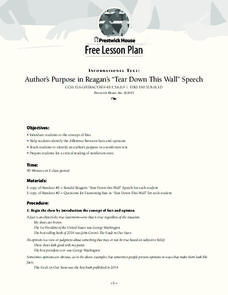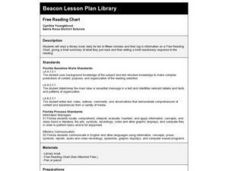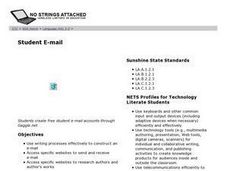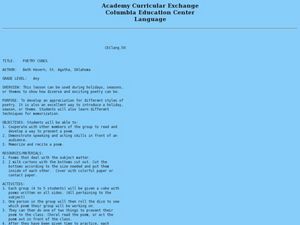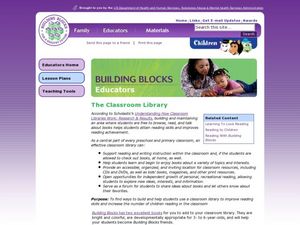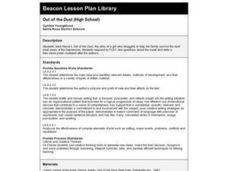Teach-nology
Author's Purpose
Challenge your class to find the three purposes for writing. After they read three short passages, kids note whether the author's purpose was to inform, persuade, or entertain.
Curated OER
Using Details from Text to Identify Author's Purpose
Explore writing techniques by analyzing newspapers and magazines with middle schoolers. They will collaborate in small groups to read local news stories and identify the main ideas and author's intent. They also utilize an information...
Curated OER
Lesson 4: Author's Purpose
Learners identify the author's purpose in various poems from the book Words with Wings: A Treasury of African-American Poetry and Art. In order to determine the purpose, pupils first observe as the teacher completes a PIES char...
Prestwick House
Author’s Purpose in Reagan’s “Tear Down This Wall” Speech
President Ronald Reagan's "Tear Down This Wall" speech, delivered on June 12, 1987 before the Berlin Wall, provides class members with an opportunity to examine three key aspects of informational text: author bias, the use of facts and...
Read Works
Changing An Author's Purpose
Some write to inform, and others to persuade. Show your class the difference between these two purposes with the instructional activity and sample essays provided here. First, model how you might change a few words in order to present a...
K12 Reader
What's the Purpose? FDR's Pearl Harbor Speech
FDR's December 7, 1941 address to the nation is the focus of a reading comprehension exercise that asks middle schoolers to read an excerpt from the Pearl Harbor speech and determine the president's purpose.
College Board
1999 AP® English Language and Composition Free-Response Questions
A released Advanced Placed exam provides scholars with an opportunity to practice their English language and composition skills. After reading two passages about Florida's Okefenokee Swamp, they write essays analyzing how the distinctive...
Curated OER
Author's Purpose
Determining an author's purpose can help readers understand a text more deeply. Using a PIES chart (persuade, inform, entertain, share) and poems from Leaf by Leaf: Autumn Poems by Barbara Rogasky, class members organize...
Curated OER
Pourquoi Tales
Lead a web search for information on writers and discuss the craft of purposeful writing as a class. Your students investigate "pourquoi tales" which are "why" stories. and then write their own examples of pourquoi stories to share in a...
Curated OER
Great Authors Acrostic Poem
In this creative writing worksheet, students use the letters in AUTHOR to write an acrostic poem. Students write a 6 line poem.
Curated OER
Free Reading Chart
Students read library books daily for ten to fifteen minutes, log information on Free Reading Chart, giving a brief summary of what they just read, and write brief reactionary response to the reading.
Curated OER
The Truth Shall Set Them Free?
Students consider the notion and purpose of truth commissions, They work in groups to predict the commission's effectiveness in its efforts to promote peace and reconciliation among Liberians. Finally, students create found poems that...
Curated OER
A Modest Proposal: Irony Made Understandable with Rock and Roll
Who doesn't love music? Poems and songs will engage your high school class in a discussion about irony. Use songs like "Rockin' in the Free World" or "Born in the U.S.A." to illustrate the ironic point of view. Print the lyrics so...
Poetry4kids
How to Host an Open Mic Poetry Party
Four steps to Open Mic Night! The location, invitations, supplies, and party favors are all part of the process in planning and hosting a fun-filled gathering where scholars read aloud an original poem or one by their favorite author.
Curated OER
Student E-mail
Guide your pupils through the process of creating a free e-mail account on Gaggle.net. Once the accounts are established, class members contact authors and practice letter writing techniques. This lesson includes resource links and is...
Curated OER
Looking Back
Students examine the difference between a communist and a free-market economy. They discuss challenges occurring in Macedonia and explain the mood of its people.
Curated OER
Poetry Cubes
Reading aloud can be scary, but it's an important way to build oral fluency. Break the class into groups of four or five learners. Each learner will roll a cube to determine which poem they read aloud to their small group. Feel free to...
Curated OER
The Classroom Library
Youngsters visit the classroom library to complete various reading activities, pushing their motivation to read! They will discuss different library books and read two specific books that use "Building Block" reading skills. They also...
Santa Ana Unified School District
Early American Poets
The poems of Walt Whitman and Emily Dickinson are the focus of a unit that asks readers to consider how an artist's life and changes in society influences his or her work. After careful study of Whitman's and Dickinson's perspectives on...
Curated OER
Puerto Rico: The 51st State?
Students explore Puerto Rico. For this Puerto Rico current events lesson, students conduct a Webquest to answer questions about Puerto Rico's culture. Students discuss whether Puerto Rico is a country or a state, and defend...
Curated OER
A History of Journal Writing
Students articulate their prior knowledge concerning the purposes of journal writing. They explore what function journal writing has fulfilled for various cultures and peoples. Students read and analyze various journal entries by famous...
Prestwick House
Catcher in the Rye Activity Pack
The Catcher in the Rye is the focus of a sampler that models some of activities included in a for-purchase packet based on J. D. Salinger's novel.
Curated OER
Out of the Dust (High School)
Fourth graders read Hesse's "Out of the Dust". They respond to questions about the novel and write a free-verse poem modeled after the author's.
Curated OER
Outlining
Learners read and evaluate a piece of expository writing. They participate in a class discussion of the outlining process and individually outline a piece of expository writing. Finally, the students create an outline for the purpose...





